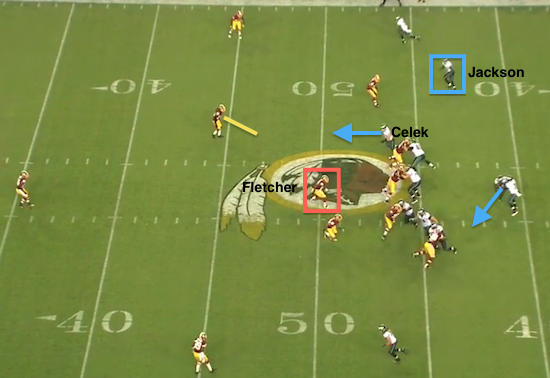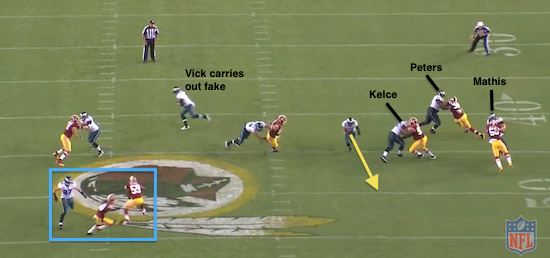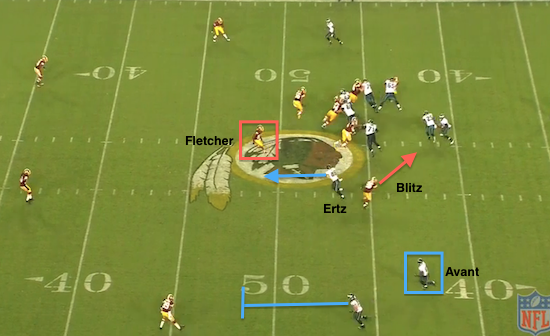All-22: Eagles Use Same Play Five Times In First Quarter
Zach Ertz lined up to the left of Jason Peters at the Eagles’ 46 yard line.
When the ball was snapped, he took off down the seam before turning his head around, finding the ball, making the catch and somersaulting to the ground for an 11-yard gain.
Ertz got up, found the official, tossed him the ball, looked towards the sideline for the next play and set up at the exact same spot in-line next to Peters.
Not a lot to think about for the rookie after his first career catch. The Eagles were about to run the same play twice in a row.
In fact, Chip Kelly called the play three times on one drive in a span of two minutes, two seconds. And in the first quarter alone, he went with it five times.
The concept is one we wrote about all preseason: packaged plays. The idea is to combine run and pass options so that calls can be made quickly and the offense can move at a fast pace.
“The downfall of tempo is that you’re not always able to adjust to what the defense is giving you in pre-snap,” said center Jason Kelce. “You’re going so fast that sometimes you’re gonna be in a good defense to stop a given play. When you have a lot of run/pass options, then you’re able to post-snap figure out what they’re doing and get into something else. So it kind of helps weather the negative part of tempo.”
The Eagles first ran this specific packaged play on their initial drive. It combines a handoff to LeSean McCoy with a screen to DeSean Jackson and a pass to Brent Celek.
The player Michael Vick is reading is linebacker London Fletcher. If he steps up to play the run, Vick delivers to Celek down the seam. Up top, you can see Jason Avant has a block set up for a screen to Jackson. And the other option is handing it off to McCoy.
Here, you can see Fletcher inches up and the slot corner tries to retreat. But it’s too late. Vick fires a dart to Celek, who picks up 28 yards.
Asked about defending the packaged plays, Celek said simply: “It’s hard. They gotta make a choice.”
One key here is that the control is all in the hands of the quarterback. Once the call is made by Kelly, Vick is the one who has to assess the defense and make the decision. The rest of the players don’t know what he’s going to do. They just do their jobs. Avant goes to block the DB. Jackson steps back in case the screen comes his way. And the offensive line executes its blocks.
“We’re just blocking the run,” said left tackle Jason Peters. “We don’t know if it’s a pass or what. We just block the play that’s called, and sometimes you look up, and the guy’s running down the field. The receiver has the ball and you don’t really know.”
On the Eagles’ very next drive, they ran the same play.
Same three options: Screen to Jackson, Celek down the seam or handoff to McCoy. But in addition to Fletcher, you see there’s a defensive back looming, waiting to crush Celek if the ball goes in his direction.
Fletcher starts up to the line of scrimmage, but then retreats. Vick ends up handing it off to McCoy.
In the blue box, you’ll see Fletcher has dropped all the way back on Celek. The tight end has two defenders on him, even though the handoff has already been made and McCoy is running through a gaping hole with good blocks from Kelce, Peters and Evan Mathis.
Fletcher also appeared to be peeking in the backfield at Vick, who was carrying out his fake to the other side of the play. The shot above shows the kind of confusion the Eagles created on Monday night.
“I think our offense is run-threat first, with just how he [Kelly] came in and installed the offense as far as pulling, giving, reading, quarterback options and things like that,” Jackson said. “On the outside, we just do a good job of making it seem like it’s either a pass or an option to be a bubble route. …We look forward to whatever situation the defense is going to give us to take advantage of.”
Later in the quarter, the Eagles ran the same play and McCoy was dropped after a gain of 1. Regardless of scheme, execution usually wins out, and Brian Orakpo beat Peters to the inside to tackle McCoy.
But Kelly came back with the same call four plays later.
This time, Vick hits Ertz down the seam for 11 yards. You can see the Redskins are blitzing the slot corner, and Fletcher once again is eyeing the handoff to McCoy. The throwing angle might have been difficult with the blitzer, but the screen was wide-open here too. Avant was set up with Riley Cooper out in front.
For the tight end, this is essentially a hot route. And once again, he doesn’t know what decision the QB is going to make.
“After three steps, I’m supposed to turn into a blocker,” Ertz said. “So if I don’t get the ball right away, then I start blocking.”
The Eagles came right back to this play after his catch, but McCoy was stopped for no gain by Kedric Golston. There was a running lane open briefly, but Golston made a nice play to get off his block and bring McCoy down.
Overall, the Eagles ran this play six times for 48 yards (8.0 yards-per-play average). It’s now on tape for the Chargers and the rest of the league to see. Kelly may try it out again on Sunday to see how San Diego defends it. And if he doesn’t like what he sees, he’ll move on to something else.
“So many different players can make plays in this type of offense,” McCoy said. “There’s so much room.”
“We’ve got so many different mix-ups. There’s some plays where it’s a run, but it can be a pass also. You just gotta guess right.”
Follow Sheil Kapadia on Twitter and e-mail him at skapadia@phillymag.com.
Become a fan of Birds 24/7 on Facebook.


